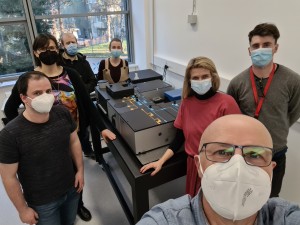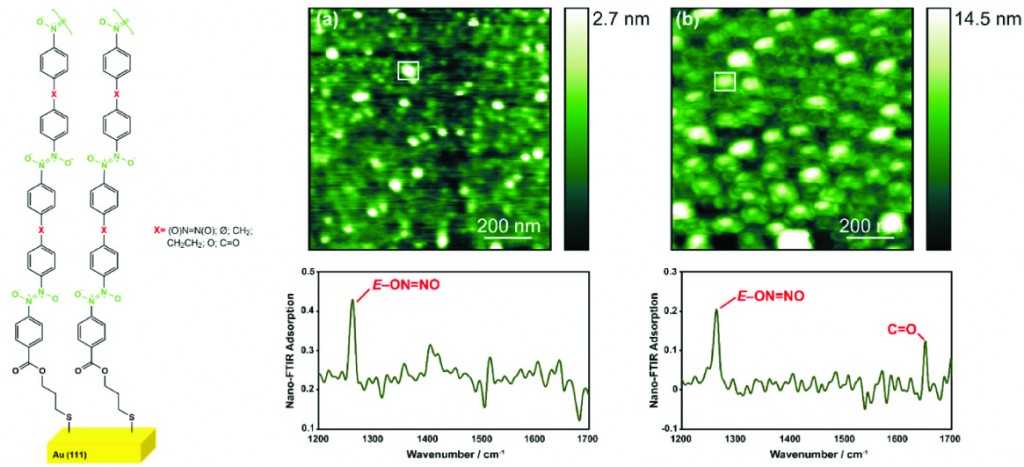This website uses cookies to ensure a better user experience.
To get more information, please read our Cookie Statement.
Application of nano-FTIR spectroscopy in studying polymerization of aromatic nitroso derivatives on Au(111) surface
Our colleagues Iva Šrut Rakić and Marko Kralj, in collaboration with prof. Biljan and her group from the Department of Chemistry, studied the polymerization of nitroso molecules on gold. The significance of this work is that for the first time, our new near-field microscope was successfully used to identify distinct molecular groups at the nanoscale. Polymerization of aromatic dinitroso derivatives initiated by nitroso-terminated monolayer on Au(111) surface: Insights from ellipsometry, atomic force microscopy (AFM) and nanoscale Fourier transform infrared (nano-FTIR) spectroscopy.
Polymerization of aromatic dinitroso derivatives initiated by nitroso-terminated monolayer on Au(111) surface: Insights from ellipsometry, AFM and nano-FTIR spectroscopy
Laura Nuić, Barbara Panić, Lovorka-Kristina Pereković, Iva Šrut Rakić, Marko Kralj, Ana Mihanović, Hrvoj Vančik, Ivana Biljan, Polymer 271, 125795 (2023).
DOI: 10.1016/j.polymer.2023.125795
Through a long-standing collaboration with prof. Ivana Biljan from the Department of Chemistry at the Faculty of Science, SIMAT group members explore the self-assembly of aromatic C-nitrosobenzene molecules on Au(111), and in particular their dimerization and bilayer formation with emphasis on revealing and resolving the structure of such layers down to the molecular scale. In the most recent experiments, the formation of azodioxy polymer thin films was studied by means of nano-FTIR spectroscopy for the first time. This is thanks to the recently installed near-field microscope at the Institute of Physics, IR-neaSCOPE+fs (Fig. 1) manufactured by Attocube Systems AG, which has nano-FTIR functionality thanks to a built-in broadband ultrafast IR laser source. The microscope is part of the Institute’s strategic infrastructural project CALT. The nano-FTIR technique is an ideal tool for a broad range of interdisciplinary research including organic (single molecules, polymers, organic semiconductors, biomaterials) and inorganic materials (oxides, minerals, semiconductors, 2D materials), and various applications such as plasmonics, excitonics, or batteries. This work combined nano-FTIR characterization with ellipsometry and AFM.

Figure 1. Photo of the near-field microscope at the Institute of Physics taken right after installation and user training session.
Ellipsometry measurements revealed an increase in film thicknesses after nitroso groups exposed at the monolayer interface were subjected to interactions with various aromatic dinitroso derivatives in solution suggesting the formation of azodioxy oligomer films. It was found that longer adsorption times lead to higher film thicknesses pointing to the greater tendency towards the formation of azodioxy oligomers. In line with that finding, AFM topography images of films taken after exposure of Au(111) substrate modified with a mononitroso derivative to different aromatic dinitroso compounds, revealed the presence of a high number of islands whose density increases with longer adsorption times. Finally, the nano-FTIR spectroscopy enabled chemical identification of the films at the nanoscale. Bands attributed to the E-azodioxy groups were detected in nano-FTIR spectra. The results strongly supported the conclusion that the islands in the AFM images represent azodioxy oligomers, the formation of which was initiated by interactions of nitroso groups at the monolayer interface with dinitroso derivatives in solution. The outlook based on this research is to further study electronic properties of such aromatic dinitroso derivatives that have been used here for the construction of azodioxy oligomer films, e.g. by performing conductivity measurements vertically through the adsorbed oligomeric chains by scanning tunneling spectroscopy, to show whether these systems are potential organic semiconductors.

Figure 2. The left schematics shows the possible formation of azodioxy polymer films on Au(111) surface by using the polymerization properties of aromatic dinitroso compounds. The right part shows 1 μm × 1 μm AFM topography images and nano-FTIR spectra of films prepared by immersion of Au(111) substrate modified with solutions containing different aromatic dinitroso compounds right after an exposure time of 72 h.




